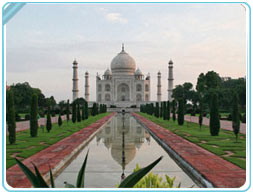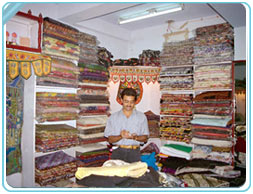How to Reach Agra

Agra is easily accessible, especially from Delhi and Jaipur. It has its own domestic airport, which is just 5 km from the city and also doubles up as the military airport. It is also well connected by a network of trains to almost all the major destinations throughout the country and some of the super-express trains that pass through it include the Rajdhani Express and the Shatabdi Express. Both the government and private buses and deluxe coaches run to and from Agra to all the nearby major destinations within and outside Uttar Pradesh. Situated in the extreme southwest corner of Uttar Pradesh, Agra stratches across 26° 44' N to 27° 25' N and 77° 26' E to 78° 32' E. Its borders touch Rajasthan to its west and south, the district of Firozabad to its East and the districts of Mathura and Etah to its North. Situated at the banks of River Yamuna, it has limited forest area sporting trees of Babul, Ber, Neem and Peepal. Agra suffers from extremities of climate with scorching hot summers and chilly winters. Monsoons offer some relief but the lanes within the city become very dirty and slippery during this season. However, the main road that stretches across the tourist area is good enough in any season. The best time to visit the city is from the Spring Season to the Autumn Season, i.e., from the months of March to October.
| In front of Akbar's Tomb |
Akbar's Tomb at Sikandra is a befitting tribute to the great Mughal Emperor. Mosaic work beautifies the southern, eastern and western gateways and the central archway of the main building. The combination of white marble and red sandstone with their contrasting colors and textures looks stunning. Abri stars inlaid in the oblong dado panels and arranging the square or rectangular pieces of multi-hued stones in geometrical and floral patterns has been elaborately used at the tomb. 'Swastik', a symbol of Hindus, has also been used for decorative purpose. Arabesque patterns in white and black marble or white and green marble can be seen on the spandrels of the arches.
Akbar started building his own mausoleum, near Agra, that was to be a perfect blend of Hindu, Christian, Islamic, Buddhist and Jain designs and motifs, bespeaking of his religious tolerance and secular views. However, he could not complete it and died. Thus, his son Jehangir completed his tomb, popularly known as Sikandra after Sikandra Lodi, who established the community where Akbar's Tomb is located.
TAJ MAHAL
On the bank of River Yamsua, the third Mughal Emperor Shah Jahan immortalized his love for his beloved queen Mumtaj Mahal by constructing this marble wonder as a tribute to her, when she died during the birth of their fourteenth child. There is a controversy on the name of the chief architect of Taj but there are many sources, which propose the name of the Indian architect of Persian origin known as Ustad Ahmad Lahori for the credit. Its construction began in 1630 and master builders, architects, skilled masons and sculptors were imported from all over the world including Persia and Europe to contribute to the beauty of Taj. Twelve years of hard labor of about 20,000 laborers and millions of rupees went into its making.
There are five main elements of the Taj complex - the main gateway or 'Darwazah', the garden with its ingenious waterways or 'Bageecha', the mosque or 'Maszid', the rest house or 'Naqqar Khana' and the main tomb building or 'Rauza'. The actual graves are kept inside while the cenotaphs are placed just above them to be viewed by the general public. The beautiful marble inlay work known as 'Pietra Dura' and the well-planned gardens of Taj with their water channels and lotus pools are some of the most impressive things to see here.
Shopping in Agra
 A shopper's paradise for those who love to buy specialties of the place as souvenirs and keepsakes or as gifts for their loved ones, Agra offers mini Taj replicas in various sizes for the tourists. This white-marble Taj is often used as decorative items in the homes and are considered to bring good luck for the lovers. However, the 'marble' can be actually the fake - a stone called 'Talk', which looks like marble, with the exception that it is not opaque like the real one. It is quite cheaper too. So, one should be careful about the quality while buying the Taj replica and pay only the right price. Leather items at Agra are famous for their quality. These include leather sandals, purses, bags and decorative items.
A shopper's paradise for those who love to buy specialties of the place as souvenirs and keepsakes or as gifts for their loved ones, Agra offers mini Taj replicas in various sizes for the tourists. This white-marble Taj is often used as decorative items in the homes and are considered to bring good luck for the lovers. However, the 'marble' can be actually the fake - a stone called 'Talk', which looks like marble, with the exception that it is not opaque like the real one. It is quite cheaper too. So, one should be careful about the quality while buying the Taj replica and pay only the right price. Leather items at Agra are famous for their quality. These include leather sandals, purses, bags and decorative items.There are lots of handicraft emporiums that offer a variety of sandalwood and rose wood items along with brass decorative pieces and stone carved images. The fine work done by the local artisans in the city is notable and the markets of Agra are the best place to explore exquisite piece of fine Zari embroidery work, stone inlay work, durries and carpets. One can find most of the big emporiums concentrated in the Gangotri at Taj complex, Sadar Bazaar and Sanjay Place. Yet, those who can steer through the narrow lanes of the city markets of Kinari Bazaar, Raja Mandi, Fuhaara and Lohamandi can get their hands on the best bargains at dirt cheap prices. One can also try Petha (sweet) and Dalmoth (salty), the famous delicacies of Agra. Petha is good for summers and can last for about a month.

No comments:
Post a Comment